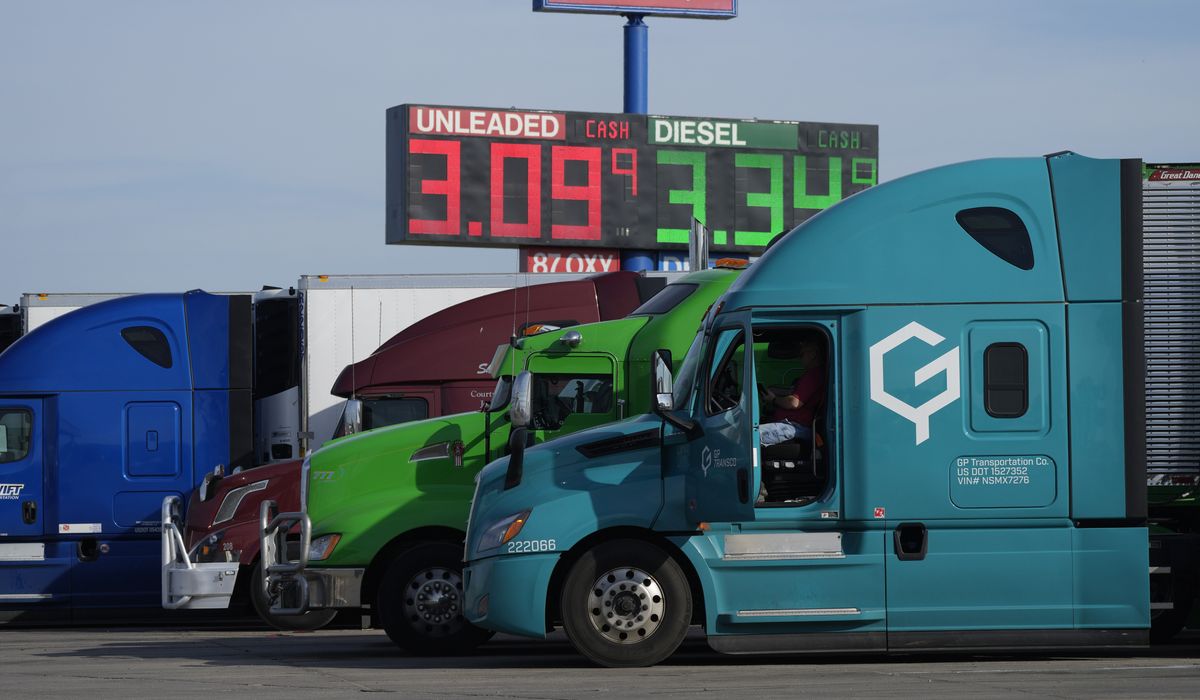
The nation’s trucking industry is facing significant headwinds in dealing with a massive shortage of drivers — just one of the factors contributing to a supply chain bottleneck that is driving up prices and threatening to put a crimp in Christmas shopping.
The trucker shortage, which the industry has warned of since at least the 1980s, has reached critical mass with the help of COVID-19 shutdowns that triggered widespread layoffs and temporarily closed state DMVs and truck driver training schools that serve as the new-driver pipeline.
“Currently, 20% to 25% of all truck drivers are still missing,” said Mike Kucharski, head of JKC Trucking, an Illinois-based company that specializes in shipping food. “JKC has trucks that desperately need drivers behind the wheel that are parked.”
The shortage of truck drivers is just one of the weak links in America’s broken supply chain that President Biden is struggling to fix. For him, the high prices and empty shelves that emanate from the huge backups at California shipping ports are a political problem, as unhappy consumers quickly become unhappy voters.
Months after the troubles manifested in the supply chain, Mr. Biden called in senior administration officials and what the White House described as “stakeholders” for a brainstorming session Wednesday.
White House press secretary Jen Psaki said the president’s supply chain task force will discuss “a range of steps that need to be taken” and are even “open to considering policies or continuing some policies” from the Trump administration.
Ms. Psaki was light on specifics about what issues would be brought up or whether the truck driver shortage was part of the conversation.
House Speaker Nancy Pelosi, California Democrat, assured Americans on Tuesday that the supply chain woes extended far beyond the U.S., noting that it was a hot topic when she huddled with Group of 20 parliamentary leaders in Rome last week.
“That was something that we talked about at the meeting because there are obstructions in other countries of products even making it to the ships that come to our country,” she said. “We’ve got to address that issue because it has a direct impact on everything because we’re so dependent on global trade and our trade going out as well.”
In the U.S., the importance of the trucking industry cannot be understated. It is the primary mode of freight transportation within the country.
“Trucks were estimated to have hauled 61 percent of the total freight (by value) transported in the United States in 2016, and this activity accounted for an estimated 3.5 percent of U.S. gross domestic product,” the Bureau of Labor Statistics stated in a recent report. “These estimates include both the for-hire trucking industry (firms providing motor freight services to customers who are shippers and receivers) and private carriage (firms hauling their own freight as an internal function within some other primary line of business).”
The trucking companies, too, are suffering from the bottleneck in the supply chain, including shortages of parts or even trucks. But the lack of drivers is the industry’s biggest concern.
According to the Bureau of Labor Statistics, the trucking industry lost 6% of its pre-pandemic workforce of 1.52 million operators — about 91,000 workers.
The American Trucking Associations said the industry faces a years-long hiring and retention crisis that was short 60,000 drivers in 2019, which it predicts will swell to 100,000 in two years.
The group estimated that with the combination of driver retirements and the expected growth in freight demand, the industry will need to hire roughly 1.1 million drivers over the next decade, or an average of nearly 110,000 per year.
Companies such as JKC, which employs 270 workers and has 200 trucks in its fleet, are still searching for operators.
Mr. Kucharski said drivers have become a commodity, and trucking companies are competing to hire them before the holiday season is in full swing.
From large signing bonuses to raising a driver’s salary to lobbying Congress on lowering the age of acquiring a commercial driver’s license to recruiting female drivers, trucking companies are seeking ways to fill the gaps.
“Whoever lost a job through the pandemic, I’d love to show them how to go to truck driving school and get a job as a truck driver if that that fits their lifestyle,” Mr. Kucharski said. “What I’m doing is just try to hire as many women truck drivers as possible or any women that are trying to get into a different field because they lost their job due to pandemic.”
Mr. Biden’s stalled $1.2 trillion infrastructure bill would open the labor market for more commercial drivers by lowering the age to attain a commercial driver’s license (CDL) from 21 to 18.
The Federal Motor Carrier Safety Administration is sponsoring a pilot program to establish different regulations on drivers, specific to their ages, Car and Driver reported.
Currently, 18-year-olds can drive commercial trucks in 49 states, but they cannot cross state lines.
• Jeff Mordock contributed to this report.








